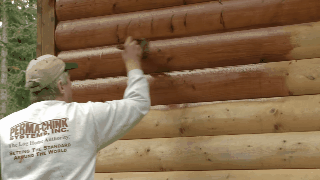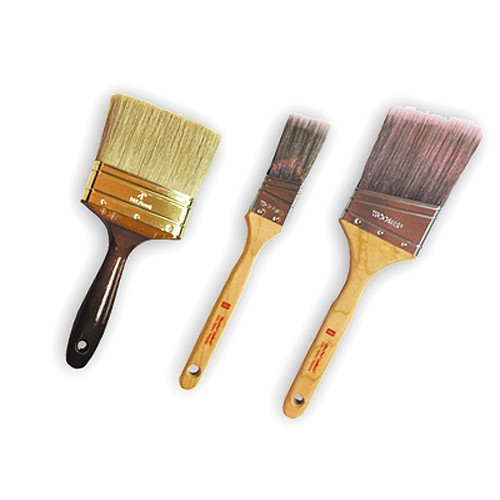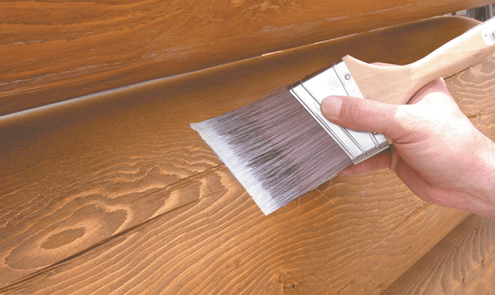Perma-Chink Systems, whose products are included in Honest Abe packages, offers tips for homeowners who wish to do their own initial finish or choose to do protective maintenance on their log home over the years. In this article they explain how to manually stain logs using the back-brush technique,
What exactly is “back-brushing” and why is it so important?
Back-brushing is the term used to describe the process of working the finish into the wood and obtaining an intact, uniform film over the entire surface. Typically used when applying stain with an airless sprayer; however, back-brushing is just as important if the product is manually applied with a brush.

Back-Brushing Benefits:
- Forces stain to penetrate the surface and seep into small fissures/cracks
- Evenly distributes applied stain over all surfaces, allowing for a smooth, uniform final finish
- No lap marks
- Very efficient, saves time and delivers beautiful results
The first step in the process is to obtain a high-quality brush. A cheap, three dollar brush will not give you satisfactory results. You need a good, quality brush like a Purdy or Wooster. For back-brushing logs, use a fairly wide brush, preferably 3” to 4” wide. Using a narrow brush takes longer and may result in visible brush marks. If you plan to hand apply the finish with a brush and pail, you will use the same brush for both the application and the back-brushing.
Quality Brushes are a Must
When applying water-based finishes like those in the Lifeline™ family, use brushes made from synthetic nylon/polyester, or blends of bristle and polyester. These brushes are durable, so they’re great for staining rough surfaces. They maintain their stiffness when exposed to water and are easy to clean. You don’t want to use a 100% natural bristle brush for applying a water-based coating, as natural bristles absorb water. You’ll end up with a limp brush that won’t work very well. Also, rough surfaces will quickly wear out a pure bristle brush.
Ever since the industry started moving away from oil-based coatings, brush manufacturers have designed brushes specifically made for the application of water-based stains and clear coats. Since transparent stains are typically much less viscous than paints, if you use a normal paint brush, the brush won’t hold much product and you’ll end up having to constantly dip the brush after just a few strokes. Use the largest brush suitable for the surface you are coating. You’ll probably need small brushes for narrow surfaces like frames and trim, but when coating logs and siding, larger brushes carry more finish; there will be less dipping to refill the brush, and fewer strokes to cover the surface. Larger brushes also do a better job when back-brushing a surface that has had a finish applied with an airless sprayer.
Perma-Chink System has all the needed tools to get your job done right. Check out our line of brushes here.
Using a Brush Correctly
Never press too hard on your brush. Stains and topcoats should be applied with the tips of the brush, not the sides. Don’t try to load too much finish on your brush. A heavily loaded brush will result in more drips and runs. Lifelinefinishes are designed to go on in thin coats, including the first coat. If applied too thick, the long-term performance of Lifeline finishes can be diminished. In other words, more is not necessarily better when it comes to applying a Lifeline finish to your log home.
 If your brush becomes messy, don’t be afraid to stop and occasionally wash it out. One of the advantages of using quality brushes is that they can be repeatedly washed without harming the brush.
If your brush becomes messy, don’t be afraid to stop and occasionally wash it out. One of the advantages of using quality brushes is that they can be repeatedly washed without harming the brush.
Care and Maintenance
If properly cleaned and maintained, a good quality brush will give you many years of good service. If you take a break even for just a few minutes, rinse your brush out with clean water and shake out the water. If you are through for the day, thoroughly wash your brush with a mild soap or detergent, shake or spin the water out and return the brush back into its original storage sleeve, it will help retain the brush’s shape while it dries.




